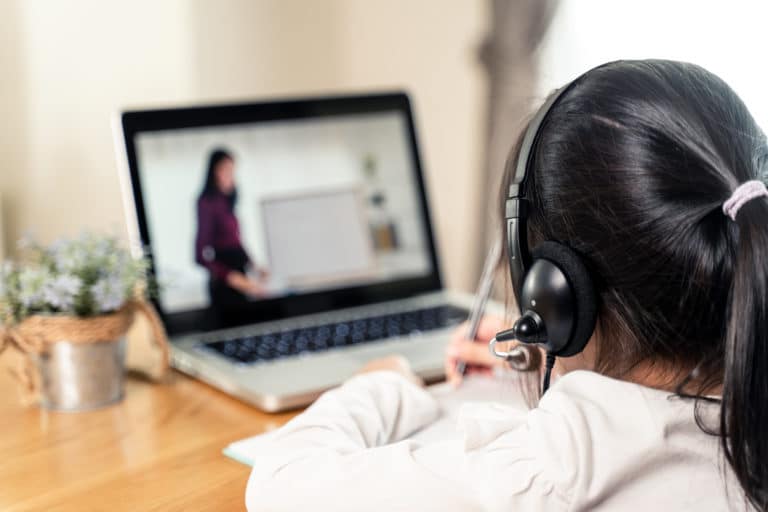
Class is the next generation virtual classroom for K-12, higher education, government agencies, and the workplace. Contact us today to schedule your live demo and see Class in action.

Class is the next generation virtual classroom for K-12, higher education, government agencies, and the workplace. Contact us today to schedule your live demo and see Class in action.

As K-12 teachers have become accustomed to some form of hybrid teaching since the start of the pandemic, they’ve learned to adjust their hybrid teaching strategies to keep students engaged. It hasn’t been an experience without some bumps in the road, but it’s fair to say that teachers, students, and families have learned a lot this year.
Hybrid classrooms combine some in-person time with synchronous virtual learning. To say managing both student cohorts at the same time has been challenging is a bit of an understatement, but teachers around the country have risen to the occasion and have found and adopted a number of hybrid teaching strategies that keep students engaged and help boost learning outcomes. Here we take a look at a few examples.
Until March 2020, most K-12 students had never experienced learning in an online environment. What’s more, most K-12 teachers also lacked experience in teaching hybrid classes, making the online environment seem somewhat unnatural at first. But teachers are finding innovative ways to make these interactions more organic and engaging. In the process, they’re also taking steps to give students a break from the technology from time to time.
Shannon F. Burghart is an associate professor of early childhood education with Guilford Technical Community College in Jamestown, North Carolina. Burghart recommends giving your students “brain breaks.”
“We know that all people, children and adults, need brain breaks,” she says. “We know that brain scans show that our brains are much more lit up after physical activity.” Burghart assigns two students to share a short brain break with the class. Typically, she says, this involves “a short song and dance in which we all get up and do a little movement where we get to laugh a little and get our blood flowing.”
A side benefit, she says, comes from giving students the opportunity to lead these brain breaks and gain a little control over the class.
The key takeaway here is to avoid approaching the hybrid classroom learning experience as a typical lecture setting. Breaking up the sessions in various ways to build in “brain breaks” can benefit both students and teachers.
It’s good to mix things up a bit when teaching hybrid classes, Burghart says. Technology offers a number of ways to do this—from quizzes and polls to breakout rooms, app sharing, and more.
But, while technology options offer great benefits for all of us, and especially for hybrid classrooms, because we’re all spending so much time these days on screens, Burghart says she likes to use as many lower-tech engagement options as she can. For example:
These are fun ideas that lend themselves well to K-12 hybrid classrooms. And, in truth, the same techniques and hybrid teaching strategies could be used in higher ed and with adult learners.

Many of us are experiencing a lot of screen time these days—some may feel too much. But just because the hybrid classroom leverages technology and screen time to facilitate learning doesn’t mean teachers don’t have the opportunity to build in some non-screen activities into their students’ days. This can be done during class, or through creative assignments designed to keep students both mentally and physically engaged.
Katie Day Good, PhD, agrees that physical movement can be a great way to break things up and keep them engaged—even outside of class time. Good is assistant professor of strategic communication at Miami University and the author of Bring the World to the Child: Technologies of Global Citizenship in American Education. Students, she says, need “movement, physical activity, and learning experiences that take place beyond their screens,” she says.
Good assigns students podcasts to listen to and urges them to go out for a walk while listening. In addition, she says: “I sometimes ask them to draw pictures in response to readings and bring their drawings to class to prompt discussion.” She also assigns film screenings and urges students to watch with others. “I think it’s important to build in off-screen engagements and connections with others wherever we can,” she says.
Alexa Sorden is the founding principal of Concourse Village Elementary School (CVES) in the South Bronx. “What’s happening in most elementary and middle schools right now is not an optimal learning experience,” Sorden says. “Schools, teachers, and families are doing their best to support children during a pandemic by making the best of hybrid and distance learning models.”
Technology has been a big boom and teachers have been learning a lot about how to use it most effectively to engage K-12 students and help them learn. When assessing how to use technology, Sorden advises teachers and administrators to “assess the why, what, when and how very carefully.” Learning about what has worked for others can help to reveal best practices and innovative techniques for capturing—and keeping—student attention. This is something that can be challenging with hybrid teaching, but teachers around the country are getting very creative about how they can do just that.
As these examples illustrate, there’s a lot we can all learn from each other. What creative approaches are you using to engage students in the hybrid learning environment?

Class is the next generation virtual classroom for K-12, higher education, government agencies, and the workplace. Contact us today to schedule your live demo and see Class in action.

Class is the next generation virtual classroom for K-12, higher education, government agencies, and the workplace. Contact us today to schedule your live demo and see Class in action.
Get our insights, tips, and best practices delivered to your inbox

Sign up for a product demo today to learn how Class’s virtual classroom powers digital transformation at your organization.

Features
Platforms
Integrations
Additional Products